Help Center
Installation and configuration of Opentrad-PuntoGal WordPress plug-in
The plug-in Opentrad-PuntoGal, based in Polylang, enables your WordPress for multilingual content and allows Opentrad to automatically translate the text of articles and pages.
Installation
First, download the opentrad-puntogal.zip file from the address indicated in the registration email.
Before installation, you will need to take into account:
- Make sure that other translation plug-ins are disabled. If it is Polylang, it is recommended to deactivate and delete the plug-in.
- Our plug-in is not compatible with the Classic Editor, so, although you can change the edition between this and the editor of the current versions of WordPress, we recommend its deactivation.
For installation:
- In your WordPress panel, go to the plug-ins list and click on “Add new”.
- Click on “Load plug-in” and select the opentrad-puntogal.zip file you previously downloaded.
- Activate the credentials.


When you install it for the first time, the configuration wizard starts automatically. The purpose is to help you get started more easily and configure the main features.
In the following step we explain the configuration with the wizard.
Configuration
When you activate the plug-in for the first time, it automatically launches the configuration wizard with all the necessary steps to easily set up a multilingual website. This will open on the same page, coming out of the WordPress administration page. Until you finish or skip it by clicking on “Back to desktop”, you will not return to your WordPress desktop.
You will need to follow each step one by one until you reach the “Done!” step at the end of the setup wizard.
On the first screen you will have the credentials for the Opentrad translation engine and the languages for your site.
1. Licenses and Languages

Indicate the ApiID and ApiKey sent in your domain registration email and save. Without these credentials you will not be able to perform the automatic translation.
The next step is undoubtedly one of the most important because your multilingual website will not work properly without any language defined.
You must define at least one language by choosing from the predefined list.
The first language you select will become the default language of your multilingual website.
Of course, before continuing with the next step, you can add other languages from the list using the “Add new language” button. You can also delete the selected ones you want.
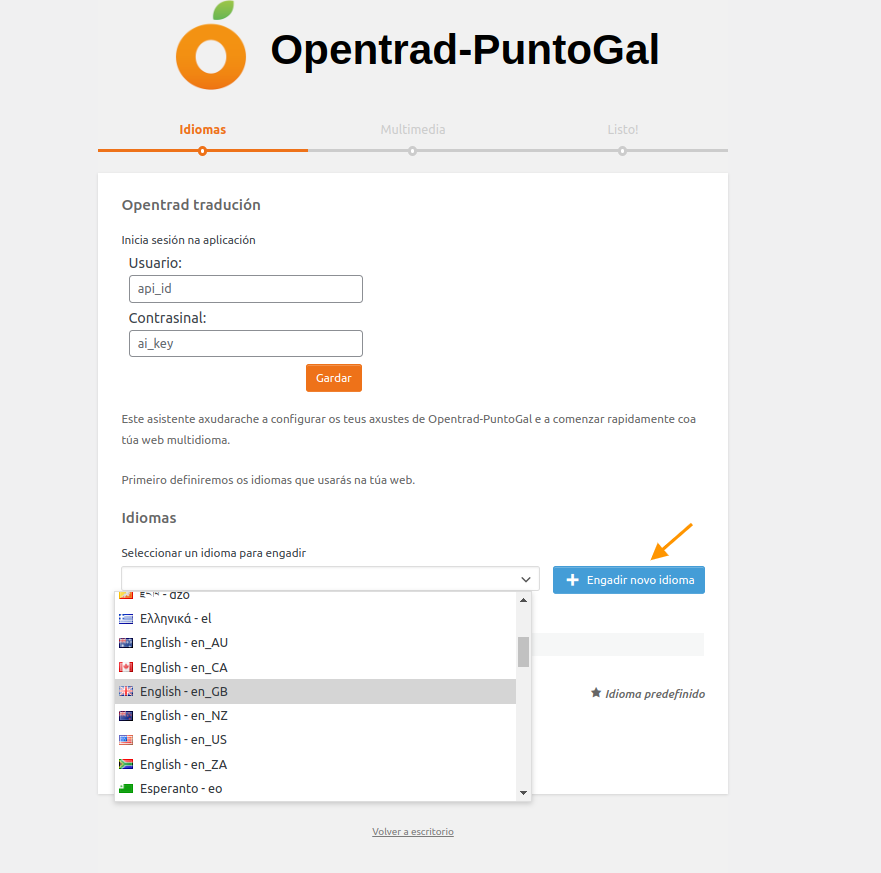
2. Multimedia
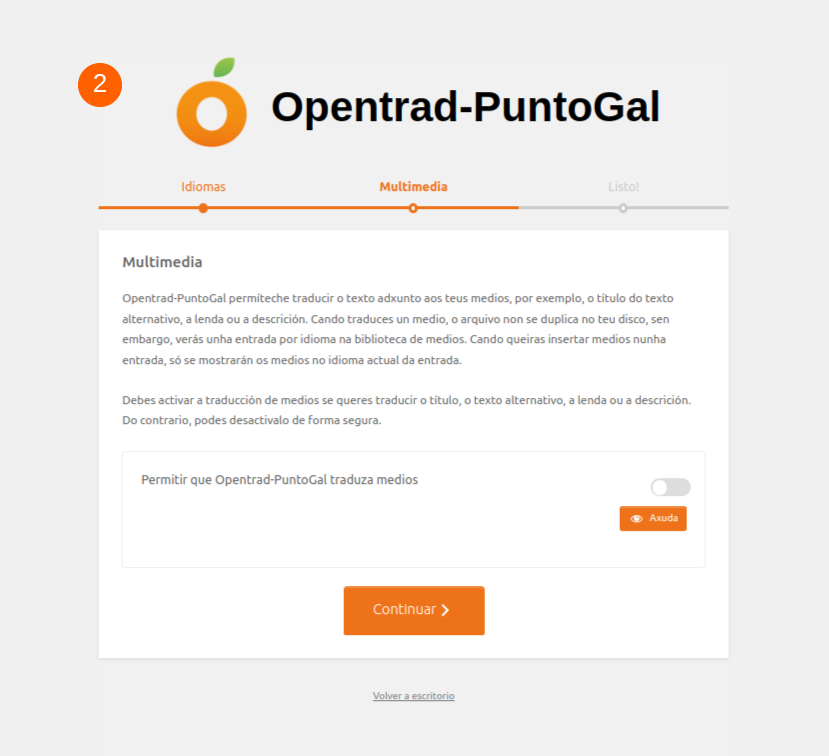
If you want to translate the multimedia fields (title, alternative text, description…) you must activate this option as shown below. This option is unchecked by default.
Please note that selecting this option does not automatically translate the multimedia fields, the media translation is done manually.
3. Done

Congratulations! You have reached the last step of the configuration wizard and you have correctly configured everything absolutely necessary for your multilingual website to work properly.
You can now manage and translate your content in each of the languages you define.
However, for your website to be ready, there are still two steps you need to perform manually:
- Add menus in each language.
- Add a language switcher so that your visitors can select the language they prefer.
For this reason, you will find a button to directly access this documentation from the configuration wizard.
You can now exit the configuration wizard by simply clicking on the “Back to control panel” button.
Please note that you can access this configuration wizard, where you will need to set if there are any changes to your credentials, via the settings, from the plug-ins panel, or from the sidebar.
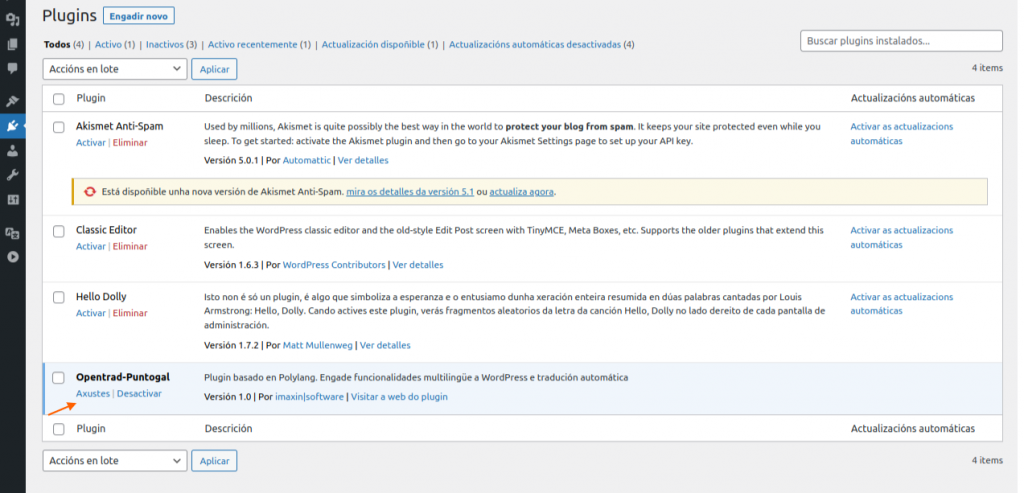
Languages > Configuration
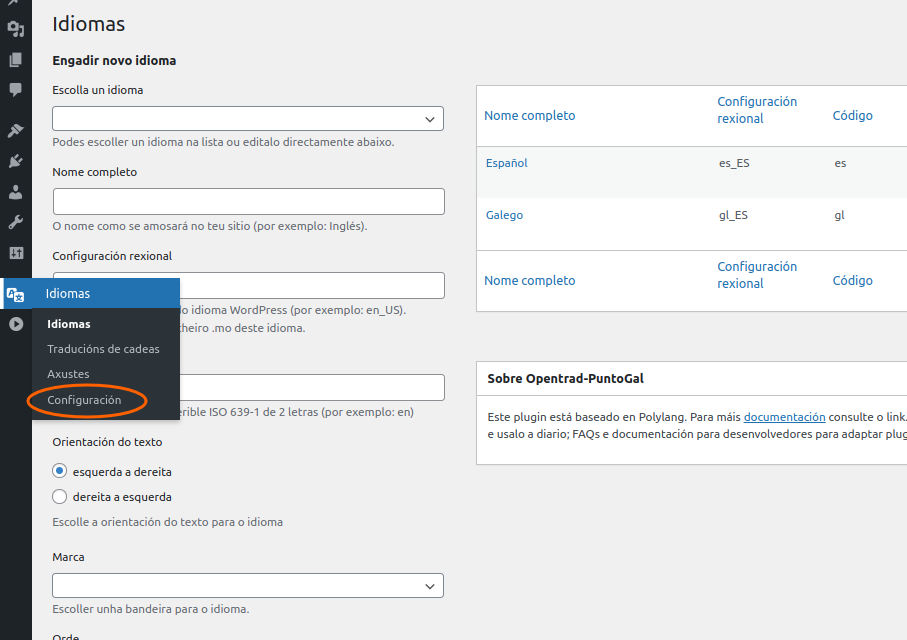
The sections of “String translation” and “Settings” will be dealt with later. It is important to remember that, in addition to the configuration wizard, the language section can be configured from this menu, as well as to identify again the predefined language of the web, placing the star in the language we choose.
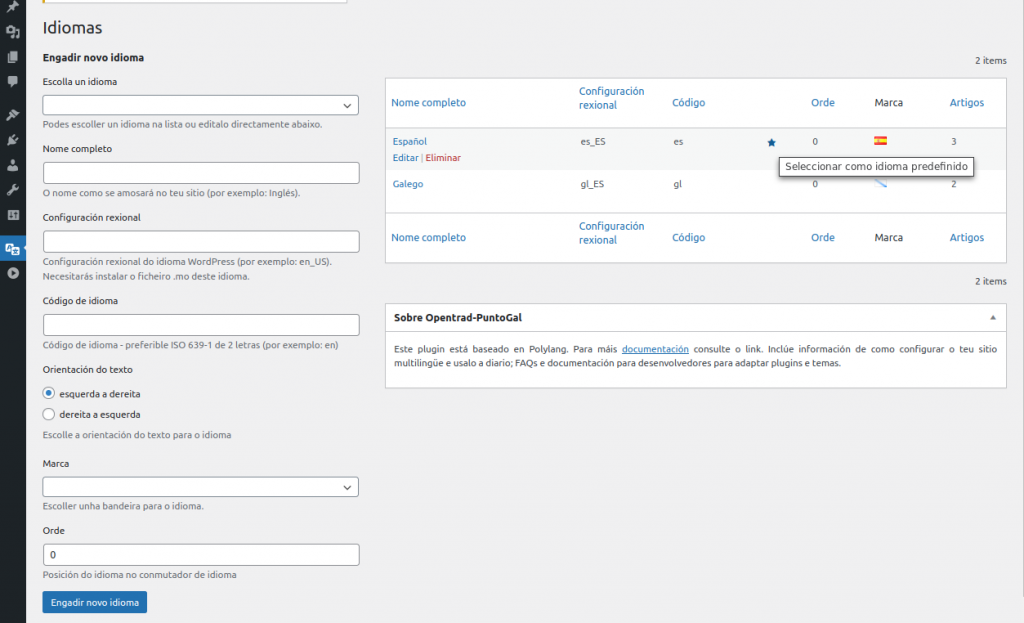
Translate text strings
Go to Languages > String translation. You must add at least one language to access this configuration.
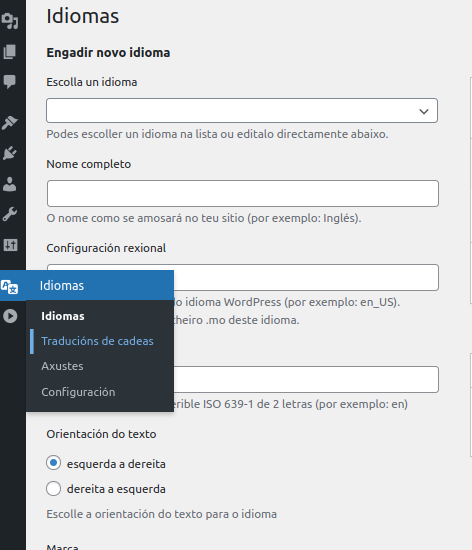

Opentrad-PuntoGal allows you to translate user-defined strings such as site title, tagline or widget titles. In addition, themes and plug-ins can allow you to translate their options here.
The String column contains the source string. You can translate it to all your languages thanks to the input fields in the Translations column. Do not forget to click on “Save changes”.
Create menus
You have to create a menu by language and save it. In “Menu options” assign your menus to the corresponding thematic localisation, for example, “Galician menu” to “Galician main menu” and “Spanish menu” to “Spanish main menu”. You have the possibility to add a language switcher anywhere in a menu. If you do not see the metabox language switcher, check that it is not disabled in the display options.
Please note that the language switcher will display a language only if at least one entry or page is published in that language.


Before adding your menu items (pages, categories…) to your menu, we recommend you to activate the administrator language filter with the same language as your menu. This can be done in the administration bar at the top of the screen. This way, make sure you add your content in the correct language. Note that you must select the correct item in the correct language to get the correct link.
Translating pages, articles, categories and tags
It is very important to set the language for all existing articles, pages, categories and tags, otherwise they will not be displayed in the front-end.
There are two ways to translate a page already created in the original language: from the editor of the created page or from the menu of the set of pages.
1. If you edit the page you will see the following:

- The flag icon means that this page is in this language. When you click on it, it will be edited. This changes the language of a page.
- By clicking on the “+” icon you can add a translation. Once pressed, a blank page will open:
-
On the page settings, when you press the “Copy source content” button, the content of the original language of the page will be copied.
-
To perform the automatic translation of the content, just press the “Translate” button and it will translate to the language in which the page was selected.
- The result is the translated page. Remember to check the translation.
-
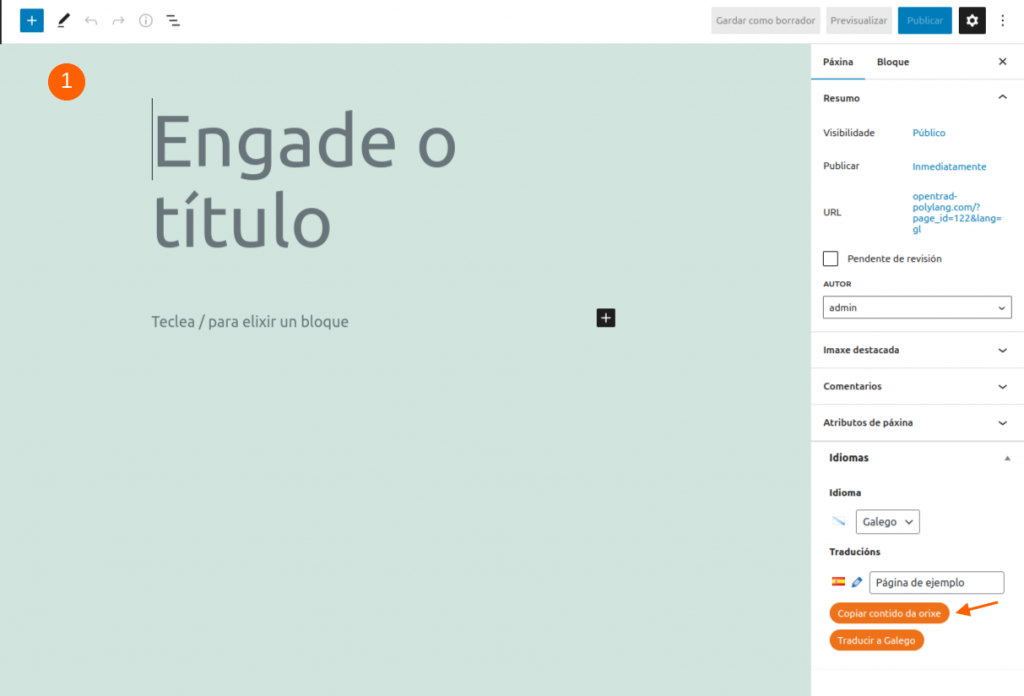


- If a pencil icon appears it means that a translation already exists. Clicking on it you can edit the translation.

- If there is already a page that is the translation of the original, you can write the title and, thanks to the system that autocompletes the text of the field, this will be assigned as a translation. And the “+” icon will pass to the pencil icon for editing.

- In the same way, if there is a translation assigned and we want to delete it, deleting the text from the language field will be enough. The icon will pass from the editing pencil to the “+” icon, and a new translation can be added. Note that deleting the translation in this way does not mean that the page is deleted. It is only unassigned as a translation.
2. If you want to add or edit a translation from the pages panel, proceed as follows. The language filter must be activated in the administrator panel (at the top) so that the translations are correctly linked.

![]()
The operation for articles is exactly the same. In the case of categories and tags, it does not include the automatic translation, but the rest of the operation is the same, selecting the translation of the language that we indicate.
It is not mandatory to translate all the content.
Define your home page as static page
Go to Settings > Reading
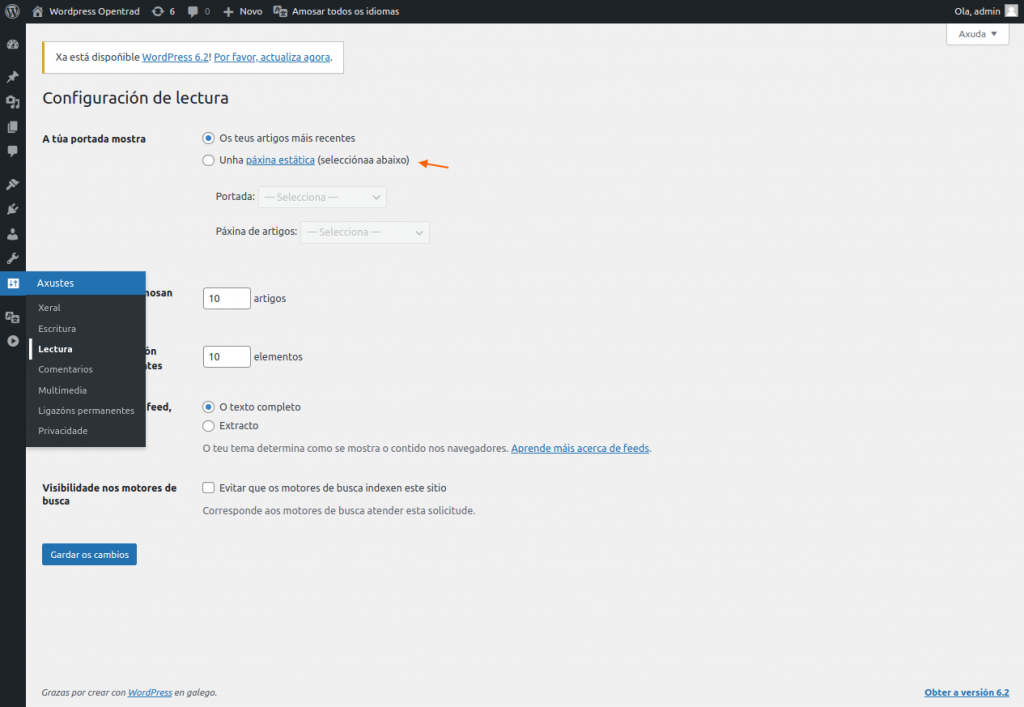
Please note that we recommend you to translate the static home page in all languages.
Choose one of the pages you have just created (the language is indifferent). This option “Home page” gives you access to a new option in Languages > Settings > Modifications URL:
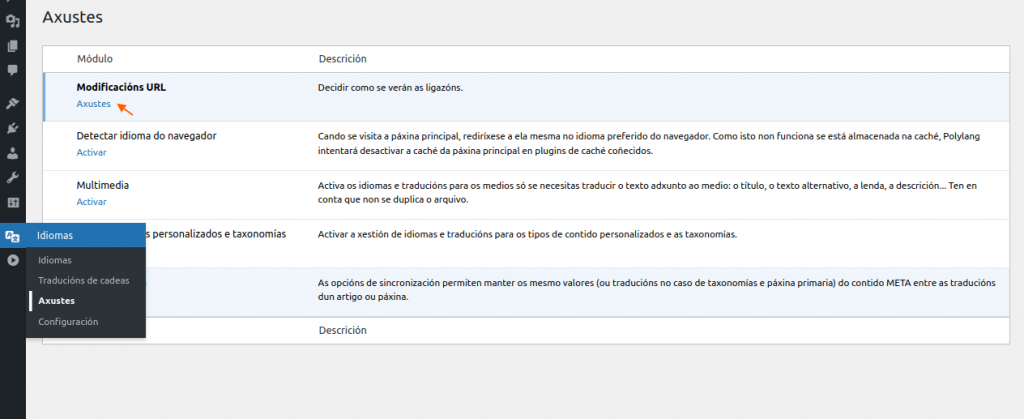
If you check this option, the URL of your home page will look as follows:
– http://www.teusitio.com/gl/
And the other one below will no longer exist (it will send a 404 error):
– http://www.teusitio.com/en/home-en-galego/
